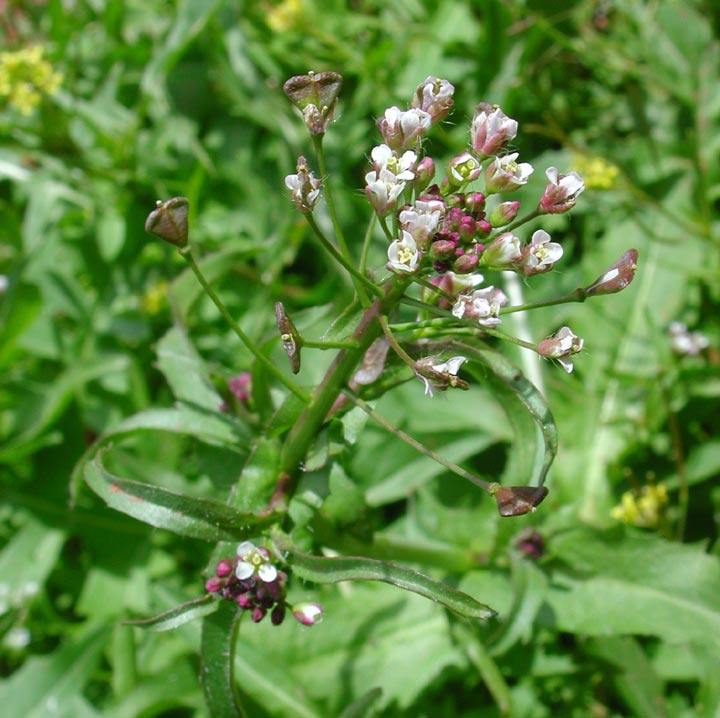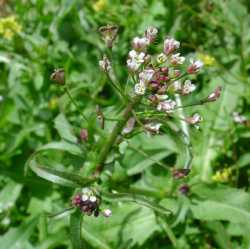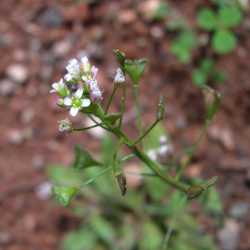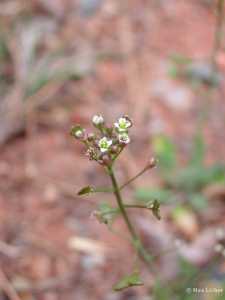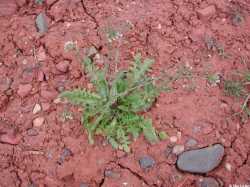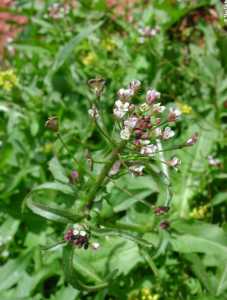Plants mostly sparsely to densely pubescent, trichomes sessile, 3-5-rayed, stellate (base of plant often mixed with much longer, simple ones). Stems (0.2-)1-5 (-7) dm. Basal leaves: petiole 0.5-4(-6) cm; blade oblong or oblanceolate, (0.5-)1.5-10(-15) cm × 2-25(-50) mm, base cuneate or attenuate, apex acute or acuminate. Cauline leaves: blade narrowly oblong, lanceolate, or linear, 1-5.5(-8) cm × 1-15(-20) mm, base sagittate, amplexicaul, or, rarely, auriculate. Fruiting pedicels usually straight, (0.3-)0.5-1.5(-2) cm, glabrous. Flowers: sepals green or reddish, 1.5-2 × 0.7-1 mm (margins membranous); petals (1.5-)2-4(-5) × 1-1.5 mm; filaments 1-2 mm; anthers to 0.5 mm. Fruits (0.3-)0.4-0.9(-1) cm × (2-)3-7(-9) mm, base cuneate, apex emarginate or truncate; valves each with subparallel lateral veins; style 0.2-0.7 mm. Seeds brown, 0.9-1.1 × 0.4-0.6 mm. 2n = 32.
Flowering and fruiting Jan-Oct. Roadsides, gardens, fields, barren gravel, pastures, plantations, lawns, orchards, cultivated ground, waste areas, vineyards, mountain slopes; 0-2800 m; introduced; Greenland; Alta., B.C., Man., N.B., Nfld. and Labr., N.W.T., N.S., Nunavut, Ont., Que., Sask., Yukon; Ala., Alaska, Ariz., Ark., Calif., Colo., Conn., Del., D.C., Fla., Ga., Idaho, Ill., Ind., Iowa, Kans., Ky., La., Maine, Md., Mass., Mich., Minn., Miss., Mo., Mont., Nebr., Nev., N.H., N.J., N.Mex., N.Y., N.C., N.Dak., Ohio, Okla., Oreg., Pa., R.I., S.C., S.Dak., Tenn., Tex., Utah, Vt., Va., Wash., W.Va., Wis., Wyo.; Europe; Asia; n Africa; introduced also in Mexico, West Indies, Central America, South America, Atlantic Islands, Pacific Islands, Australia.
According to M. Coquillat (1951), Capsella bursa-pastoris is the second most common weed on earth, after Polygonum aviculare.
Annual herb 10 cm - 0.6 m tall
Stem: upright, slightly branched, covered with star-shaped hairs.
Flowers: in branched, terminal clusters, white, 3 - 4 mm wide. Petals four, longer than sepals. Stamens six.
Fruit: a pod, on 1 - 2 cm long stalks, widely diverging, 4 - 8 mm long, narrowly heart-shaped to triangular, somewhat flattened.
Basal leaves: in a rosette, stalked, 5 - 10 cm long, oblong, pinnately lobed, minutely toothed and bristly along the margins, hairy.
Stem leaves: alternate, stalkless, clasping, much smaller than basal leaves, lance-shaped to linear with a lobed base (typically pointed), sometimes toothed, hairy.
Similar species: Capsella bursa-pastoris is the only representative of the genus Capsella in the Chicago Region. Its wedge-shaped fruit pods are distinctive.
Flowering: mid-March to October
Habitat and ecology: Introduced from Europe. Now found all over the world. In the Chicago Region, this common weed is found in waste ground, pastures, gardens, and other disturbed areas. Also found growing along railroads.
Occurence in the Chicago region: non-native
Notes: The fruit pods are said to resemble a medieval shepherd's purse.
Etymology: Capsella is Latin for "a little box." Bursa-pastoris is the literal translation of "shepherd's purse."
Author: The Morton Arboretum
A frequent to common weed throughout the state in cultivated grounds, lawns, and pastures and along roadsides and railroads. The plant is very variable and has been the subject of much study by Almquist and Shull. Almquist, in 1920, writes as follows: "Among 370 races from different countries I was able to find at least 70 species that remained constant in culture during two or three generations. At present I have published descriptions of 200 constant forms." My specimens are variable, and, no doubt, several of the elementary species of this complex occur in Indiana.
Duration: Annual
Nativity: Non-Native
Lifeform: Forb/Herb
General: Annual introduced herb; stem 20-50 cm, simple or occasionally branched above; pubescent below with stellate hairs, usually glabrous above.
Leaves: Basal leaves 3-16 cm long, 1-3 cm wide, toothed to (more often) pinnately divided or lobed into angular, forward-pointing lobes or segments; stem leaves greatly reduced upwards and auriculate-clasping.
Flowers: Inflorescence many-flowered; pedicels spreading or ascending, 10-15 mm long; petals 2-4 mm long, white to pinkish.
Fruits: Silicles 5-8 mm long, 3-5 mm wide, shaped like an inverted triangle with the top side dented.
Ecology: Disturbed areas up to 9,000 ft (2740 m); flowers March-September.
Notes: Oddly shaped silicles are distinctive and the source of the common name -shepherd-s purse.- Host plant for Checkered White, Cabbage White, and Sara Orangetip butterflies.
Ethnobotany: Cheyenne use leaves and stems for head pain. Chippewa, Costanoan, and Mahuna all use plant for painful diarrhea. Menominee use plant wash to alleviate poison ivy discomfort. Mohegan eat seed pods to kill internal worms. Apache, Chiricahua, and Mescalero use seed flour for bread. Mendocino eat seed as staple grain. Cherokee use leaf spice in cooking. Seeds are known to stimulate digestive juices, which aids in the digestive process. The seeds are also useful in stopping internal or external bleeding.
Etymology: Capsella is ancient word for small box, depicting the fruit. Bursa-pastoris translates to sheperd-s purse.
Synonyms: Bursa bursa-pastoris, Bursa gracilis, Capsella rubella, Thlaspi bursa-pastoris
Editor: SBuckley, 2010
Sparingly branched annual or winter-annual 1-6 dm; basal lvs oblong, 5-10 cm, pinnatilobate; cauline lvs much smaller, lanceolate to linear, entire or denticulate, auriculate; racemes becoming much-elongate; pedicels at maturity divaricate, 1-2 cm; sep 2 mm; pet 1.5-4 mm; fr triangular-obcordate, with straight to slightly concave or slightly convex margins, 4-8 mm; 2n=16, 32. Probably native to s. Europe, now a cosmopolitan and ubiquitous weed. (C. gracilis; C. rubella; etc.)
Gleason, Henry A. & Cronquist, Arthur J. 1991. Manual of vascular plants of northeastern United States and adjacent Canada. lxxv + 910 pp.
©The New York Botanical Garden. All rights reserved. Used by permission.


